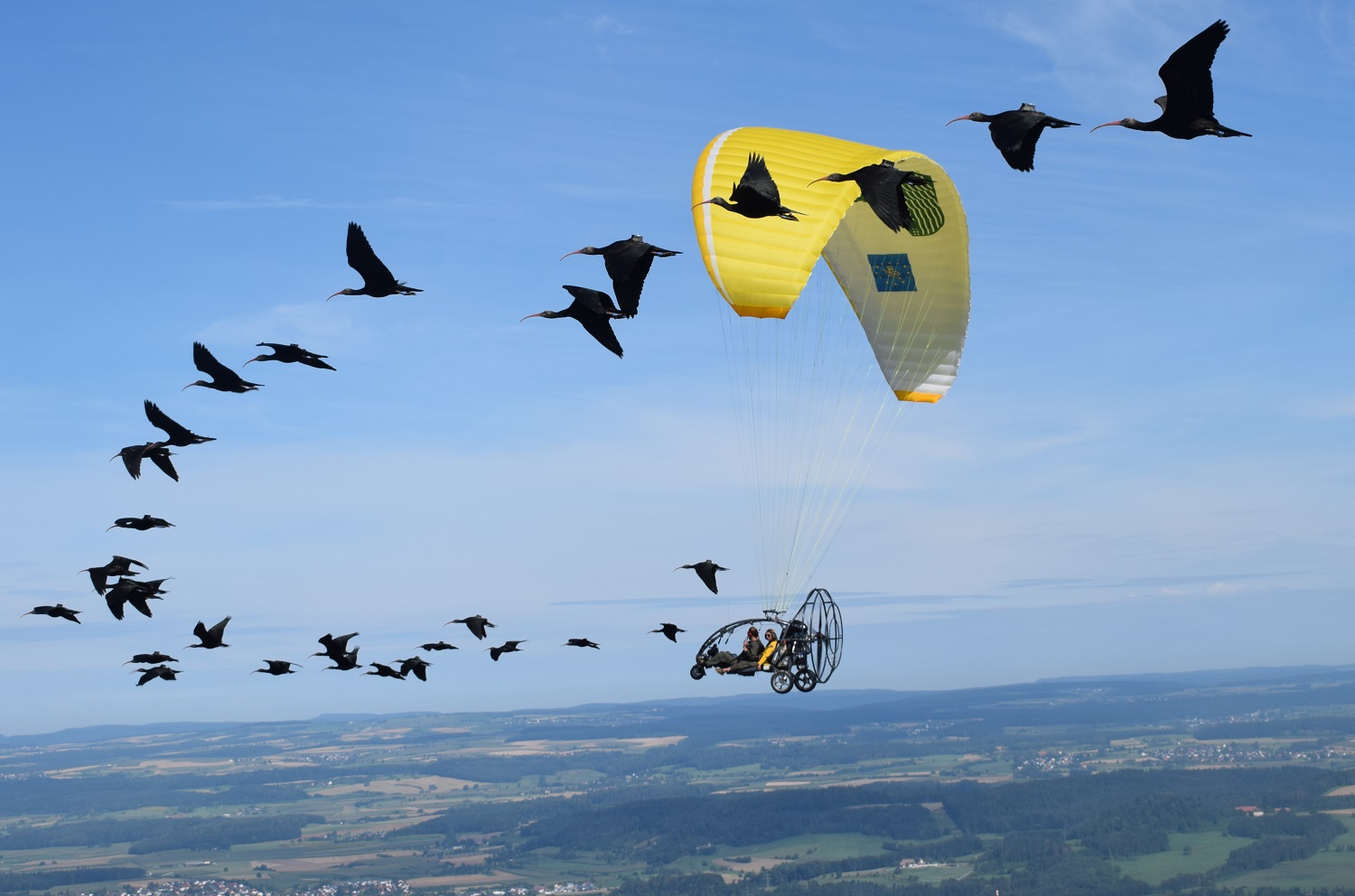No survival without teamwork
Newsletter 02/11/2020
Press information of the Austrian Science Foundation (FWF) regarding the research project FWF P 30620, which runs in the frame of our NBI reintroduction project.
Migratory birds flying south provide an impressive example of cooperative behaviour that saves power and energy. In the past it was impossible for scientists to study this phenomenon in a natural environment. Researchers who guided young Northern Bald Ibises to their wintering grounds have now succeeded for the first time in obtaining a comprehensive data set. A better understanding of this behaviour is also of fundamental importance in respect of climate change.
Who has not seen this fascinating phenomenon: The precise alignment of migratory birds flying south in V-formation. Not only is it visually impressive, this flight formation is also a special example of cooperative behaviour in the animal kingdom. Up to now, however, the only possible approximation to the phenomenon was through using mathematical models and simulations, because the necessary empirical data could not be collected using wild migratory birds.
One of Europe’s large species conservation project, which also received funding from the EU LIFE programme (LIFE+12-BIO_AT_000143), offers an extraordinary framework for a research project that is funded by the Austrian Science Fund FWF (FWF P 30620) and is scheduled to run until the end of 2021.
In 2018 and 2019, the research team guided two groups of young Northern Bald Ibises on their first migration from a breeding colony in Überlingen on Lake Constance to their wintering grounds in southern Tuscany, the WWF Oasi Laguna di Orbetello. Flying with the birds in an ultralight aircraft, the researchers performed the function of lead bird, which was necessary because it was the premiere of migratory flight for these young birds. This is the only way to reintroduce the Northern Bald Ibis, which is extinct in Europe, into the wild. In addition, climate change is increasingly impinging on migratory birds, which is why research into migratory flight is of great importance for European species conservation. It will become increasingly important to be able to model the migratory behaviour of species accurately and adapt it to changing environmental conditions.
In this context, cooperation skills between individuals play a key role in determining the survival of the individual bird as well as that of the entire population. The first migration is particularly risky for young birds: if a young Ibis loses contact with its flock and is unable to join any other group, it is condemned to certain death. While it was known, in principle and from theoretical models, that formation flight saves energy, researchers did not know how that works and how much energy a bird actually saves.
From the question of how the data is collected to analysis of the data, the researchers had to break new ground several times. For this reason, the team includes the PhD students Elisa Perinot from Italy and Ortal Rewald from Israel as well as partners from research institutes at the Vienna University of Veterinary Medicine, the University of Vienna, the Joanneum University of Applied Sciences in Graz and the University of Berne.
The exact position of one individual in relation to the others – is it flying ahead or behind – is a key aspect in researching energy efficiency. All individuals were therefore equipped with extra-light-weight data loggers. Every day, the researchers mounted the devices on the birds and took them off again. It was particularly challenging for the team to achieve the extremely high precision to the nearest few centimetres. The feat was made possible by access to three global satellite navigation systems (GPS, Galileo, GLONASS). A bird only saves energy if it flies at a certain distance from the bird in front and also precisely synchronises its wing beat. Therefore, a motion sensor in the data logger continuously measures both the wing-beat frequency and the position of the wing. The researchers also measured the heart rates of four birds via electrodes to find out how much energy the individual saves in the process. In order to be able to relate the heart rate to energy expenditure (the metabolic rate) which is measured via the air breathed, it was necessary to calibrate these two values under laboratory conditions. In a specifically developed wind tunnel, the “foster parents” of four separately reared young birds collected data on this issue.
In the course of the two migrations, the team collected a comprehensive and novel set of data. The analysis of the data is ongoing. Due to simulations the team expects that the energy savings will be between 15 and 30 percent. This is considerable, especially for inexperienced young birds with lower performance capabilities. With the help of this empirical database, human-guided migration can be further improved, thereby optimising the protection of migratory bird species.
One question remains: is this cooperative behaviour something the birds have in their genes or is it the result of learning-by-doing? Apparently, cooperation skills are the result of a development process. The researchers noted that during the training flights, they were still a motley crew. When they got into the spirit for migration, they seemed to recognise the seriousness of the matter and began to fly in formation. With each stage of the flight, cooperation became better.
Picture:
The man-guided flights offer the unique opportunity for this research project. Every bird wears an aerodynamically optimized high-tech data logger on its back.





